Related Research Articles
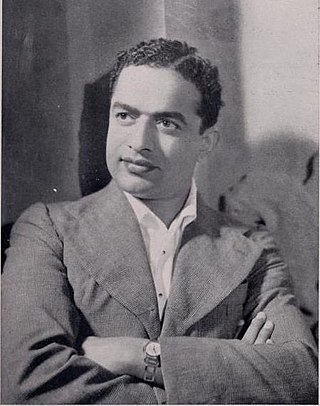
Shantaram Rajaram Vankudre, referred to as V. Shantaram or Shantaram Bapu, was an Indian filmmaker, film producer, and actor known for his work in Hindi and Marathi films. He is most known for films such as Dr. Kotnis Ki Amar Kahani (1946), Amar Bhoopali (1951), Jhanak Jhanak Payal Baaje (1955), Do Aankhen Barah Haath (1957), Navrang (1959), Duniya Na Mane (1937), Pinjara (1972), Chani, Iye Marathiche Nagari and Zunj.
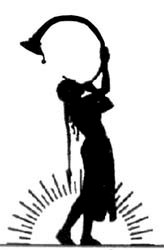
Prabhat Film Company was an Indian film production company and film studios founded in 1929 by the noted film director V.Shantaram and his friends.

Keshavrao Date (1889–1971) was an Indian film actor, who worked in both silent and sound movies. He tried to run his own drama company but found it difficult to perform the dual roles of manager and actor.
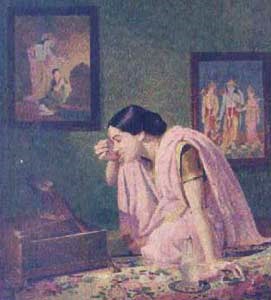
Kunku is a 1937 Marathi classic social drama film directed by V. Shantaram, and based on the novel, Na Patnari Goshta by Narayan Hari Apte, who also wrote film's screenplay. The film was simultaneously shot and released in Hindi as Duniya Na Maane.

Chandra Mohan was an Indian actor, known for his work in Hindi cinema in the 1930s and 1940s. He became known for his villainous roles in a number of critical and commercial successes.
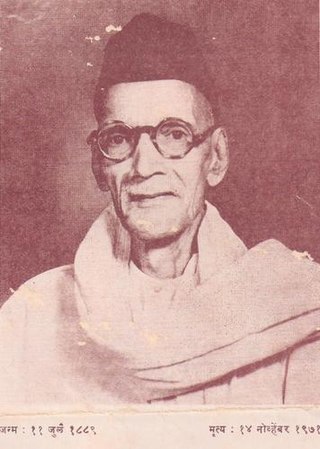
Narayan Hari Apte, popularly known as Nanasaheb Apte was a Marathi popular novelist, writer of advice books and editor from Maharashtra, India.
Vishnupant Govind Damle was an Indian production designer, cinematographer, film director and sound engineer for Marathi films. His 1937 film Sant Tukaram was the first Indian film to be screened at an international film festival. It won a "Special Recommendation" at the 5th Venice International Film Festival.
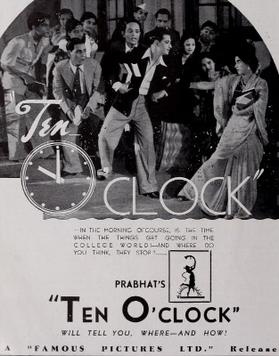
Das Baje, also called 10 O'Clock, is an Indian film. It was released in 1942. This was a debut direction for Raja Nene, a protege of V. Shantaram, and produced under Shantaram's Prabhat Film Company banner. The film was a bilingual, made in Hindi, and in the Marathi language as Daha Wajta. The music direction was by Keshavrao Bhole. The story was written by Kashyap and Pawar, with dialogues in Hindi by Ashant. The photography was by E. Mohammed. It starred Paresh Bannerji, Urmila and Vasant Thengdi in the lead roles, with Baby Shakuntala and Manajirao forming the supporting cast.

Keshav Vaman Bhole, also known as Keshavrao Bhole, was a well-known music composer and critic in Indian cinema.
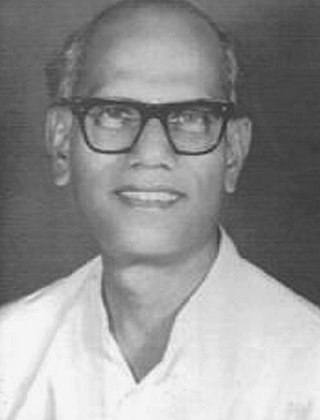
Shantaram Govind Athavale was an Indian director of Marathi, Hindi and English language films, a lyricist, poet, and author. Part of the generation that emerged from the Prabhat Film Company in Pune in the 1930s, he made pioneering contributions to Marathi film.

Chandrasena is a 1935 Hindi/Marathi mythology drama film directed by V. Shantaram for his Prabhat Film Company. The film was the first Indian trilingual film to be made simultaneously in Hindi, Marathi. The cinematographer was K. Dhiaber and the story and dialogue were by Shivram Vashikar. The music direction was by Keshavrao Bhole, with lyrics written by K. Narayan Kale. The cast included Nalini Tarkhud, Sureshbabu Mane, Kelkar, Rajani, Shantabai and Azurie.

Amar Jyoti is a 1936 Hindi social, action adventure, drama film directed by V. Shantaram. Produced by Prabhat Film Company and cited as a "noteworthy" film along with Shantaram's earlier Amrit Manthan (1934), the film had actress Durga Khote performing one of her most "memorable" roles. K. Narayan Kale wrote the story with dialogues by Narottam Vyas. The music was composed by Master Krishnarao. The director of photography was V. Avadhoot, and the cast included Durga Khote, Chandra Mohan, Shanta Apte, Nandrekar, Vasanti and Narayan Kale.
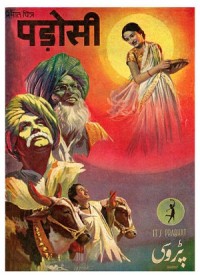
Shejari is also known as Padosi in Hindi version as. Padosi is a 1941 Indian social drama film directed by V. Shantaram. It was produced by Prabhat Film Company and the bilingual film in Marathi and Hindi was the last film Shantaram made for Prabhat before venturing to form his Rajkamal Kalamandir. The film is cited as one of the three social classics Shantaram made at Prabhat. The other two were Duniya Na Mane (1937) and Aadmi (1939). The story and dialogue were by Vishram Bedekar in the Marathi version, while the dialogues in the Hindi version were by Pandit Sudarshan, who also wrote the lyrics. The music director was Master Krishnarao. The famous character artist Radhakrishan made his acting debut in the film as a villain. The film starred Mazhar Khan, Gajanan Jagirdar, Anees Khatoon, Radha Kishan, Lajwanti, Sumitra, Gopal and Balak Ram.

Udaykal is a 1930 historical silent film co-directed by V. Shantaram and Keshavrao Dhaiber. It was produced by Prabhat Film Company. The story was written by Baburao Pendharkar. The cinematographers were S. Fattelal and V. G. Damle. The film starred V. Shantaram, Baburao Pendharkar, Kamla Devi, G. R. Mane, Ibrahim and Dhaiber.
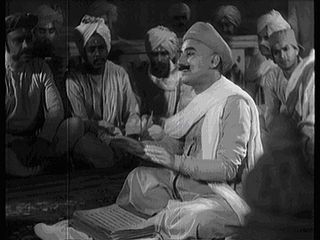
Dharmatma is a 1935 Indian social devotional biopic directed by V. Shantaram. The film was a bilingual made in Marathi and Hindi. This was the only devotional film directed by Shantaram, though he had made several mythological films. The story and screenplay were by K. Narayan Kale and the music was composed by Master Krishnarao. The cast included Bal Gandharva in his debut role and Chandra Mohan as the villain, with Master Chhotu, K. Narayan Kale, Ratnaprabha, Vasanti and Hari Pandit.
Rani Saheba also called Bazarbattu is a 1930 Indian silent film. It is cited as the first children's film made in India. The film was co-directed by V. Shantaram and Keshavrao Dhaiber. The cinematographers were S. Fattelal and Vishnupant Govind Damle and the cast included Keshavrao Dhaiber, Baburao Pendharkar, V. Shantaram and Anant Apte.

Manoos, also called Life's for Living, is a 1939 Indian Marathi social melodrama film directed by V. Shantaram. The movie was simultaneously made in Hindi as Aadmi. The film was based on a short story called "The Police Constable". The story was by A. Bhaskarrao, with screenplay and dialogue by Anant Kanekar. The cinematographer was V. Avadhoot and the music was composed by Master Krishna Rao, with lyrics by Kanekar. The cast included Shahu Modak, Shanta Hublikar, Sundara Bai, Ram Marathe, Narmada, Ganpatrao and Raja Paranjpe.
Chandrasena is a 1931 Indian silent film directed by V. Shantaram and Keshavrao Dhaiber. The director of photography was Keshavrao Dhaiber. Produced under the banner of Prabhat Film Company, the film brought the company into the "frontline" of film makers. The cast included Lila, "alias" Lilavati Pendharkar, who was making her debut with this film, with Kamla, Gulabbai and G. R. Mane.
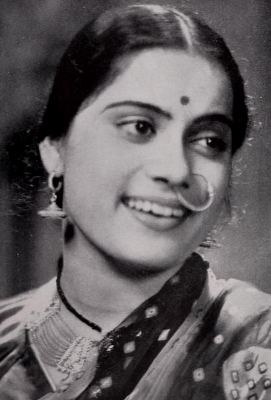
Shanta Apte (1916–1964) was an Indian actress-singer who worked in Marathi and Hindi cinema. Renowned for her roles in films like Duniya Na Mane/Kunku (1937) and Amar Jyoti (1936) under the Prabhat Films banner, she was active in Indian cinema from 1932 to 1958. Apte's impact on Marathi cinema "paralleled" that of Kanan Devi in Bengali cinema. Along with Kanan Devi, Apte is cited as one of the "great singing stars" from before the playback singing era. Apte began her career in films playing the role of a young Radha in the Marathi film Shyamsunder (1932). She joined Prabhat Films acting in her first Hindi language film Amrit Manthan in (1934).
References
- ↑ CITWF. "Amrit Manthan 1934". citwf.com. Retrieved 20 August 2014.
- 1 2 Banerjee, Srivastava (2013). Hundred Indian Feature Films: An Annotated Filmography. Routledge. ISBN 9781135841058 . Retrieved 20 August 2014.
- 1 2 Chandra, Balakrishnan, Pali, Vijay Kumar. "Amrit Manthan 1934". indiavideo.org. Retrieved 20 August 2014.
{{cite web}}: CS1 maint: multiple names: authors list (link) - ↑ Jasraj, Madhura Pandit (15 July 2015). V. Shantaram: The Man Who Changed Indian Cinema. India: Hay House, Inc. ISBN 978-93-84544-41-6.
- ↑ Jasraj, Madhura Pandit (15 July 2015). V. Shantaram: The Man Who Changed Indian Cinema. Hay House, Inc. ISBN 978-93-84544-41-6.
- ↑ "Films of Prabhat Film Company". prabhatfilm.com. Retrieved 25 January 2021.
- ↑ "India 1931–1940". moviemoviesite.com. Archived from the original on 23 October 2015. Retrieved 17 October 2015.
- ↑ "India 1931–1940". moviemoviesite.com. Archived from the original on 23 October 2015. Retrieved 17 October 2015.
- ↑ Ahuja, M. L. Eminent Indians: Film Personalities. India: Rupa Publications. ISBN 9788129133342 . Retrieved 20 August 2014.
- ↑ Chowdhry, Prem (2000). Colonial India and the Making of Empire Cinema: Image, Ideology and Identity. UK: Manchester University Press. ISBN 9780719057922 . Retrieved 20 August 2014.
- ↑ Lal, S. (2008). 50 Magnificent Indians of the 20Th Century. India: Jaico Publishing House. ISBN 9788179926987.